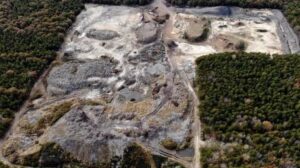
 An aerial view of the site of a proposed ashfill at the Brookhaven Town landfill on Horseblock Road. Credit: Brookhaven Town
An aerial view of the site of a proposed ashfill at the Brookhaven Town landfill on Horseblock Road. Credit: Brookhaven Town
By The Editorial Board
Updated December 5, 2020 5:00 AM
This crisis for Long Island comes with a due date: December 2024.
That’s when the Brookhaven Town landfill is slated to close. The mammoth dumping ground used by much of the region for nearly a half-century is expected to run out of space then, which will precipitate a major problem.
What to do with our trash?
Disposing of garbage is expensive, and various methods have different consequences for our health, environment and infrastructure. And even though post-landfill proposals are emerging and being vetted, the lengthy process of acquiring permits from several layers of government and then building on Long Island means we’re getting closer to having to call these last-minute solutions.
Fortunately, there’s still time for the analysis and deliberation needed to make decisions which will work for all of Long Island, because getting rid of our garbage is a truly regional problem. Unfortunately, as with many other issues, Long Island has no mechanism to effect a regional solution. In other parts of New York, counties handle solid waste disposal. But here, responsibility lies with 13 towns and two cities, and each makes its own deals.
The Long Island Association business group and the Long Island Regional Planning Council intend to spearhead a discussion of the looming crisis beginning early next year. That’s good. There’s a lot to talk about, though neither organization can require or mandate anything, even if it wanted to. Most of the new proposals are sited in Brookhaven Town, which will bear a large burden in the approval process. But the best bet for comprehensive guidance is the state Department of Environmental Conservation, which must issue permits for any new facility. The DEC should approach its task with a best-for-the-region orientation.
The numbers define the stakes. Brookhaven’s landfill takes in 387,000 tons per year of construction and demolition debris (called C & D) and 351,000 tons of ash, the product of burning household trash in three of the four waste-to-energy plants on Long Island run by Covanta. The rest of Long Island has one private landfill in Melville for C & D and one other ash fill, in Babylon, which takes only that town’s ash and also will close within a decade.
New proposals include:
- A plan from the Winters Bros. solid-waste management company for a waste transfer station adjacent to the Brookhaven landfill in Yaphank that would take in C & D, load it on train cars, and ship it off Long Island via a spur line to the Long Island Rail Road’s Main Line.
- A waste transfer station pitched by Gershow Recycling, to collect C & D at its Medford facility and ship it out, also by train and also on the Main Line.
- A third waste transfer station sited in Brentwood proposed by Omni Recycling, to take C & D and municipal solid waste off Long Island by rail, again on the Main Line.
- A new landfill for ash only at the site of the Brookhaven landfill, to be run by Brookhaven Town.
These proposals will be viewed as competing. They shouldn’t be. They are potential components of an overall solution. But there are many questions to be answered before deciding on the best mix.
Start with some baseline principles to inform the process:
- We need to take trucks off our roads and with them the congestion, pollution and wear-and-tear they create, not increase their numbers by carting more of our garbage off the Island. Rail must be part of the solution.
- We need to boost our abysmal recycling rates — the less waste to process, the better. Long Islanders produce on average 4.5 pounds per day of municipal solid waste. Already, the region produces more cardboard waste than ever, from shipping boxes of online shopping. Another big target: glass, which currently ends up mostly in landfills, incinerated or otherwise. Expanding the state bottle bill to add deposits on wine, liquor and other types of glass bottles would help. So would developing new markets; crushed or powdered glass can be made into sand or substituted for Portland cement. The garbage stream could be reduced further by an anaerobic digester in Yaphank to turn biodegradable organic waste like food and grass clippings into energy and compost; it awaits one final agreement with Suffolk County.
- We need to weigh carefully the environmental burden placed on neighboring communities by new facilities.
Then ask questions:
- With an increased reliance on rail and multiple providers of that, what is the region’s track and rail car capacity? What would happen during service interruptions or ebbs and flows in garbage collection? What sort of storage facilities are required in those events? How much redundancy of service is required?
- Are additional industrial uses or these new facilities being planned, and are they desirable?
- How much capacity should a new ashfill have? Will that calculation change if Covanta succeeds in adding to its roster of customers — for example, by signing contracts with North Hempstead and Oyster Bay towns, which truck their garbage off Long Island?
- The state has invested in studying a deep water port for Long Island. Is there any role for shipping out garbage by water?
Long Island’s garbage is a complex problem urgently needing a solution. We have no time to waste.
— The editorial board
By The Editorial Board


